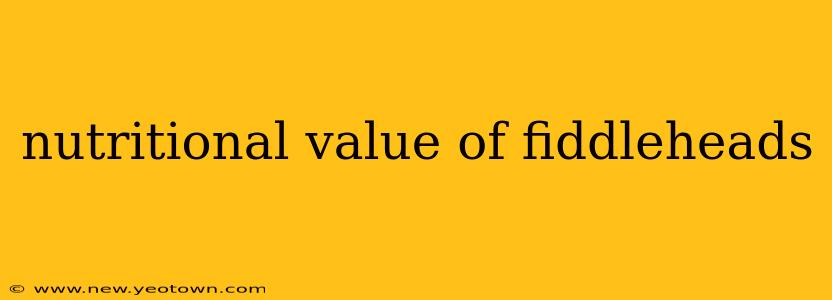Fiddleheads, those captivatingly curled fern fronds, have captivated foragers and chefs alike for centuries. But beyond their intriguing appearance lies a nutritional powerhouse packed with vitamins, minerals, and antioxidants. This isn't just a trendy superfood; it's a culinary delight with a history rich in both taste and health benefits. Let's unfurl the secrets of this unique spring vegetable.
What are Fiddleheads?
Before we delve into the nutritional aspects, let's establish what exactly fiddleheads are. They are the young, tightly furled fronds of certain fern species, most commonly Matteuccia struthiopteris (ostrich fern). Harvested in early spring, they resemble tiny, coiled fists – hence the name "fiddleheads." Their unique flavor profile is often described as a blend of asparagus, green beans, and spinach, with a slightly bitter undertone.
Nutritional Value of Fiddleheads: A Vitamin and Mineral Bonanza
Fiddleheads are a nutritional goldmine. A single serving (approximately one cup) offers a significant amount of essential nutrients:
- Fiber: Fiddleheads are an excellent source of dietary fiber, contributing to digestive health and promoting feelings of fullness. This is crucial for maintaining a healthy weight and preventing constipation.
- Vitamin C: This potent antioxidant supports immune function and protects cells from damage. Fiddleheads provide a decent amount of Vitamin C, contributing to overall well-being.
- Vitamin A: Important for vision, immune function, and cell growth, Vitamin A is present in fiddleheads in the form of beta-carotene, which the body converts as needed.
- Magnesium: This essential mineral plays a critical role in numerous bodily functions, including muscle and nerve function, blood sugar control, and blood pressure regulation.
- Manganese: Another crucial mineral, manganese contributes to bone health, wound healing, and metabolism.
- Potassium: Important for maintaining healthy blood pressure and fluid balance, potassium is another nutrient found in significant amounts in fiddleheads.
- Iron: Essential for oxygen transport throughout the body, iron contributes to energy production and overall health.
Are Fiddleheads Safe to Eat? Important Considerations
While incredibly nutritious, it's crucial to understand that fiddleheads must be properly prepared before consumption. Raw fiddleheads contain thiaminase, an enzyme that can interfere with the body's ability to utilize thiamine (vitamin B1). This is why thorough cooking is absolutely essential. Boiling, steaming, or sautéing are recommended methods to neutralize thiaminase.
Furthermore, it's vital to only harvest and consume fiddleheads from reputable sources. Incorrectly identifying a fern species can lead to consuming poisonous plants. If you're foraging, consult with an expert to ensure you're harvesting the safe variety.
How to Incorporate Fiddleheads into Your Diet
The versatility of fiddleheads opens up a world of culinary possibilities. They can be:
- Steamed: A simple and effective way to preserve their nutrients.
- Sautéed: Adds a delightful flavor boost when sautéed with garlic and butter.
- Added to salads: Provides a unique texture and flavor to fresh salads.
- Roasted: Roasting enhances their natural sweetness.
- Used in omelets or frittatas: A great way to add a nutritious and flavorful twist to breakfast.
What are the potential health benefits of eating fiddleheads?
The abundant nutrients in fiddleheads contribute to several potential health benefits, including:
- Improved digestion: Due to their high fiber content.
- Boosted immunity: Thanks to their vitamins C and A.
- Better blood pressure control: Attributable to their potassium and magnesium content.
- Enhanced bone health: Supported by their manganese and other minerals.
Are there any risks or side effects associated with eating fiddleheads?
As mentioned previously, improper preparation can lead to thiamine deficiency. Additionally, some individuals may experience mild digestive discomfort, such as gas or bloating, after consuming fiddleheads. It's advisable to start with a small portion to assess your individual tolerance.
How many calories are in fiddleheads?
A one-cup serving of cooked fiddleheads contains approximately 40-50 calories, making them a relatively low-calorie, nutrient-dense food choice.
What are the best ways to store fiddleheads?
Fresh fiddleheads should be refrigerated and used within a few days of purchase or harvesting. They can also be frozen for later use, although freezing may slightly alter their texture.
This comprehensive exploration of the nutritional value of fiddleheads reveals a spring vegetable that's not only delicious but also a significant contributor to a healthy diet. By understanding the benefits, risks, and preparation methods, you can confidently incorporate this unique culinary delight into your meals. Remember, always prioritize safe sourcing and proper cooking techniques.

